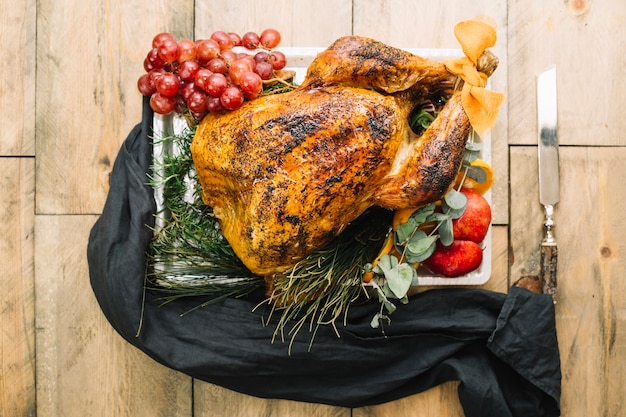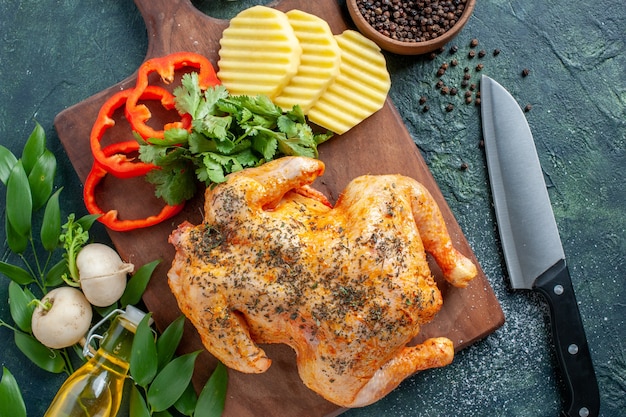Can chicken be a little pink?
When it comes to cooking chicken, we are often told to ensure that it is fully cooked to avoid any risk of foodborne illnesses. But what about when you cut into a piece of chicken and it’s still a little pink near the bone? Is it safe to eat? The answer may surprise you.
Understanding chicken doneness
Chicken, like any other meat, needs to reach a safe internal temperature to kill any harmful bacteria that may be present. According to the UK Food Standards Agency, the recommended internal temperature for chicken is 75°C (165°F). This temperature ensures that any harmful bacteria, such as Salmonella or Campylobacter, are destroyed, reducing the risk of food poisoning.
Why does chicken sometimes appear pink?
The pink color in cooked chicken can be attributed to several factors. Firstly, the myoglobin protein found in chicken can give it a pink hue, even when fully cooked. Additionally, some chickens may have been raised with naturally occurring pigments, such as hemoglobin, that can also cause a slight pink tinge.
Furthermore, certain cooking methods, such as grilling or smoking, can create a pinkish color on the surface of the chicken, even if it has reached a safe internal temperature. This is known as the “smoke ring” and is a common occurrence in barbecued meats.
Is it safe to eat pink chicken?
In most cases, if the chicken has reached an internal temperature of 75°C (165°F), it is safe to eat, even if it still appears slightly pink near the bone. However, it is important to use a food thermometer to ensure the chicken has reached the recommended temperature.
Did you know? The Food Standards Agency recommends using a food thermometer to check the internal temperature of cooked chicken, as color alone is not a reliable indicator of doneness.
It is worth noting that ground chicken should always be cooked until it reaches an internal temperature of 75°C (165°F) throughout, with no traces of pink. This is because grinding can introduce bacteria from the surface of the meat into the interior, increasing the risk of foodborne illnesses.
Tips for cooking chicken safely
To ensure your chicken is cooked safely, here are some tips:
- Use a food thermometer to check the internal temperature.
- Wash your hands and surfaces thoroughly before and after handling raw chicken.
- Avoid cross-contamination by keeping raw chicken separate from other foods.
- Cook chicken thoroughly, reaching an internal temperature of 75°C (165°F) throughout.
Is Woody Chicken Safe to Eat?
When it comes to poultry, the texture and quality of the meat are crucial factors. However, sometimes you may come across chicken that has a woody texture, which can be off-putting and raise concerns about its safety to consume.
What causes woody chicken?
Woody chicken typically occurs when birds are bred to grow rapidly, resulting in an abnormal development of their muscle fibers. As a result, the meat becomes tough, chewy, and fibrous, resembling the texture of wood. This condition is known as woody breast or woody chicken syndrome.
The Safety of Woody Chicken
Despite its unappetizing texture, woody chicken is safe to eat. There are no health risks associated with consuming woody chicken, as it is not caused by any bacterial contamination or disease. The texture may be undesirable, but it does not pose any harm to your health.
How to identify woody chicken?
It is relatively easy to identify woody chicken before cooking. Look for chicken breasts that have an unusually firm and rubbery texture, with white striations running through them. This texture may hinder the absorption of marinades and sauces during cooking, resulting in a drier end product.
How to deal with woody chicken?
While woody chicken is safe to eat, you may still want to avoid it if possible. Here are a few tips to help you deal with woody chicken:
- Look for alternative cuts: Instead of chicken breasts, consider using thigh or leg meat, which are less prone to woody texture.
- Tenderize the meat: Use a meat tenderizer or marinate the chicken to help break down the muscle fibers and improve the texture.
- Cook with sauces or moist heat methods: Braising, stewing, or slow cooking can help soften the meat and make it more palatable.
Remember, despite the woody texture, woody chicken is still safe to eat. However, if the quality of the meat concerns you, feel free to explore alternative cuts or cooking methods to ensure an enjoyable dining experience.
Is Bloody Chicken Safe to Eat?
When it comes to cooking chicken, one of the biggest concerns is ensuring that it is thoroughly cooked to prevent any foodborne illnesses. It is common knowledge that undercooked chicken can be dangerous, but what about chicken that appears bloody even when cooked? Is it safe to eat?
The Appearance of Blood in Chicken
Contrary to popular belief, the presence of blood in cooked chicken does not necessarily mean it is undercooked or unsafe to eat. The red liquid often found in cooked chicken is not actually blood, but rather a protein called myoglobin. Myoglobin can retain a red or pink hue even after the chicken is fully cooked, especially in younger birds.
Ensuring Safety
While the presence of bloody chicken is generally safe, it is still important to ensure that the meat is cooked to an appropriate temperature to kill any potential bacteria. The recommended internal temperature for chicken is 165°F (74°C). By using a food thermometer, you can accurately determine if the chicken is cooked to a safe temperature.
Cooking Tips
Here are some essential tips to keep in mind when cooking chicken to ensure safety:
- Always wash your hands before and after handling raw chicken.
- Thoroughly clean any cutting boards or utensils that come into contact with raw chicken to prevent cross-contamination.
- Avoid washing chicken before cooking as it can spread bacteria.
- Use a food thermometer to check the internal temperature of the chicken.
- If you’re unsure about the safety of the chicken, cook it for a few extra minutes.
Remember, it’s better to be safe than sorry when it comes to consuming chicken.
According to the UK Food Standards Agency, it is estimated that around 280,000 cases of food poisoning occur each year due to the consumption of undercooked chicken.
In conclusion, while the appearance of blood in cooked chicken may be off-putting, it is generally safe to eat as long as it reaches the recommended internal temperature. By following proper cooking practices and using a food thermometer, you can ensure the safety and deliciousness of your chicken dishes.
Is the White Stuff on Chicken Safe to Eat?
Chicken is a staple in many households and a versatile protein choice for a variety of dishes. However, sometimes you may notice a white, creamy substance on raw chicken, which can spark concerns about its safety. In most cases, there is no need to worry as this substance is simply a mixture of water and proteins.
What is the White Stuff on Chicken?
The white stuff on chicken, often referred to as “chicken slime,” is a naturally occurring protein called albumin. Albumin is found in both raw and cooked chicken and tends to accumulate on the surface of the meat when it comes into contact with water or other liquids.
Did you know? The presence of albumin is not an indication of spoilage or contamination.
Is it Safe to Eat?
Yes, the white stuff on chicken is safe to eat. It is a normal part of the chicken and does not pose any health risks. Cooking the chicken thoroughly will kill any bacteria or pathogens that may be present. Therefore, as long as the chicken is cooked to the recommended internal temperature of 165°F (74°C), it is safe to consume.
Tips for Handling Chicken Safely
While the white stuff on chicken itself is harmless, it is essential to handle chicken safely to prevent cross-contamination and ensure food safety. Here are some tips:
- Always wash your hands before and after handling raw chicken.
- Use separate cutting boards and utensils for raw chicken to avoid cross-contamination with other foods.
- Store chicken properly in the refrigerator or freezer to prevent bacterial growth.
- Thaw frozen chicken in the refrigerator or using the defrost function on your microwave.
- Clean and sanitize any surfaces or utensils that come into contact with raw chicken.
By following these guidelines, you can ensure the safety of your chicken and reduce the risk of foodborne illnesses.
In Summary
The white stuff on chicken is a mixture of water and proteins called albumin, which is safe to eat. It is not an indication of spoilage, but proper handling and cooking of chicken are essential for food safety. By following good hygiene practices and cooking chicken thoroughly, you can safely enjoy this delicious protein.



